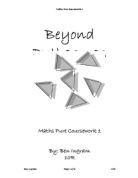Maths Dice Investigation
Rules 10 counters are placed in the centre of the dodecahedron. Two dice are then rolled the amount of the two numbers on the dice are then recorded. A counter from the centre of the dodecahedron is then placed into "A" wins or "B" wins depending on the sum of the two numbers. E.g. 3 + 2 = 5 therefore it goes into A wins 6 + 4 = 10 so obviously B wins And so on. this continues until there are no counters remaining inside the dodecahedron. Prediction I predict that B will win because it is more likely to get the numbers that when added together make the sum of the numbers found in B. Results Game Counters in A Counters in B Who won ? 5 5 draw 2 4 6 b won 3 3 7 b won 4 5 5 draw 5 5 5 draw 6 4 6 b won 7 3 7 b won 8 6 4 a won 9 2 8 b won 0 4 6 b The results table clearly see that after rolling 2 dice 10 times the number of counters placed in either "A" wins or "B" wins add up to 10. This is obviously because we used 10 counters. After carefully looking at the results table it becomes apparent that "A Wins" "B Wins" Win = 1 Win = 6 Draw = 3 Draw = 3 Lose = 6 Lose = 1 We can write this as a probability equation: P(A Wins) =
Beyond Pythagoras - I am investigating the relationships between the lengths of the three sides of right angled triangles, the perimeters and areas of these triangles.
CONTENTS Introduction....................................................2 Proof of Pythagoras' Thereom........................4 Prediction........................................................6 Workings.........................................................7 The Table of Results......................................12 Workings.......................................................13 The Table of Results......................................18 nth term for 'length of shortest side'.............19 nth term for 'length of middle side'...............21 nth term for 'length of longest side'..............23 nth term for 'perimeter'................................25 nth term for 'area'.........................................27 Pattern.........................................................28 The End........................................................29 Investigation: Beyond Pythagors Introduction I am investigating the relationships between the lengths of the three sides of right angled triangles, the perimeters and areas of these triangles. I was set to predict about Pythagorean triples, make generalisations about the lengths of sides and make generalisations about the perimeter and area of corresponding triangles. Pythagorean triples or triad are a set of three positive integers (a, b and c) they are representing the sides of a triangle and satisfying
Spoleèná dopravní politika.
Ekonomicko-správní fakulta Masarykovy univerzity Letecká doprava v EU Martin Chromec 15. listopadu 2003 SPOLECNÁ DOPRAVNÍ POLITIKA Spolecná dopravní politika patrí mezi ty politiky Evropské unie, které se staly soucástí procesu evropské integrace v dobe založení EHS v roce 1957, a ustanovení o této politice Spolecenství proto mužeme najít už v Rímské smlouve. Bylo k tomu nekolik závažných duvodu: * Ekonomická integrace a její postup rozširuje obchod mezi zememi, což si vyžaduje spolehlivé fungování dopravy. Tento sektor je klícovým odvetvím, což je potvrzováno také tím, že jeho príspevek k rustu hrubého domácího produktu (7-8 %) je vetší než príspevek zemedelství. * Doprava napomáhá volnému pohybu zboží a osob, což je predpoklad jednotného vnitrního trhu. V sektoru dopravy je treba vytvorit takové konkurencní podmínky, aby se dopravní náklady nestaly bariérou obchodu. * Dopravní sektor pohlcuje 40 % verejných investic v zemích Unie a jeho fungování ovlivnuje mnoho dalších sfér a hospodárských cinností. Citelné jsou dopady na regionální rozvoj, na situaci životního prostredí, na utvárení krajiny a plánování velkých aglomerací, na spotrebu energie aj. Postavení dopravního systému v zemích Spolecenství, má-li být vnitrní trh skutecne funkcní, vyžaduje integraci mezi zememi
Dice Maths Investigation
The instructions above tell us how to play a very simple dice game that relies on probability. From the offset, we can see that the game is an unfair one as the probability of one of the players winning varies. Below is a table showing us how different dice roles affect each player. Dice Number 2 3 4 5 6 A Wins B Wins C Wins We can see that the distribution of numbers is not even. However, the probability of each player winning is conditional because if A throws a one, the game finishes and B does not get a chance to throw. To illustrate this more clearly I have created a conditional probability tree diagram: From this simple diagram, the following results are easily obtainable: st Round 2nd Round 3rd Round 4th Round A 1/6 5/108 25/1944 25/34992 B 5/18 25/324 25/5832 625/104976 C 5/18 25/324 25/5832 625/104976 The most important thing I found that each probability had in common with one another, except Player A's first term, was that all the numbers on top were divisible by five and that all the bottom numbers were divisible by 18: 25/5 = 5...324/18 = 18...625/5 = 125...104976/18 = 5832. You will notice that when any of the probabilities are divided by 5/18 the result is the previous probability. This is because the probability of a player winning is multiplied by the probability of all the previous rounds passing. Seeing as the
Research on Pythagoras and his work.
Beyond Pythagoras Introduction: Research on Pythagoras and his work Pythagoras of Samos is often described as the first pure mathematician. He is an extremely important figure in the development of mathematics yet we know relatively little about his mathematical achievements. Unlike many later Greek mathematicians, where at least we have some of the books which they wrote, we have nothing of Pythagoras's writings. The society which he led, half religious and half scientific, followed a code of secrecy which certainly means that today Pythagoras is a mysterious figure. We do have details of Pythagoras's life from early biographies which use important original sources yet are written by authors who attribute divine powers to him, and whose aim was to present him as a god-like figure. What we present below is an attempt to collect together the most reliable sources to reconstruct an account of Pythagoras's life. There is fairly good agreement on the main events of his life but most of the dates are disputed with different scholars giving dates which differ by 20 years. Some historians treat all this information as merely legends but, even if the reader treats it in this way, being such an early record it is of historical importance. Pythagoras's father was Mnesarchus, while his mother was Pythais and she was a native of Samos. Mnesarchus was a merchant who came from Tyre, and
Pythagoras [Samos, 582 - 500 BC].
Pythagoras [Samos, 582 - 500 BC] Like Thales, Pythagoras is rather known for mathematics than for philosophy. Anyone who can recall math classes will remember the first lessons of geometry that usually start with Pythagoras famous proposition about right-angled triangles: a²+b²=c². Pythagoras found this principle two and a half millennia ago -around 532 BC- and with it his name and philosophy have survived the turbulences of history. His immediate followers were strongly influenced by him, and even until today Pythagoras shines through the mist of ages as one of the brightest figures of early Greek antiquity. What he found out about triangles has been the beginning of mathematics in Western culture, and ever since mathematics -the art of demonstrative and deductive reasoning- has had a profound influence on Western philosophy, which can be observed down to Russel and Wittgenstein. Pythagoras' influence found an expression in visual art and music as well, particularly in the renaissance and baroque epoch. The far-reaching imprint of his ideas is yet more impressive if we consider that he did not leave any original writings. Instead, all what is known about Pythagoras was handed down by generations of philosophers and historiographers, some of whom, like Heraclitus, opposed his views. In this light it is remarkable that Pythagoras' teachings have survived relatively
Beyond Pythagoras P.1 Pythagoras Theorem is a2+b2= c2 'a' is being the shortest side, 'b' being the middle side and 'c' being
Mahmoud Elsherif Beyond Pythagoras P.1 Pythagoras Theorem is a2+b2= c2 'a' is being the shortest side, 'b' being the middle side and 'c' being the longest side (hypotenuse) of a right angled triangle. The numbers 3,4,5 satisfy this condition and so 32+ 42=52 Because 32= 3*3=9 42=4*4=16 52=5*5=25 32+ 42=52 9+16=25 25=25 This proves Pythagoras Theorem goes with the right angled triangle with the numbers 3,4,5. Next I shall prove that Pythagoras's Theorem applies to 5,12,13 right angled triangle. 52+122=132 Because 52= 5*5=25 22= 12*12=144 32= 13*13=169 Mahmoud Elsherif Beyond Pythagoras P.2 This satisfies the Theorem of Pythagoras's goes with these numbers 5,12,13. Finally I shall prove that Pythagoras's Theorem applies to 7,24,25 right angled triangle. 72+ 242=252 Because 72= 7*7=49 242= 24*24= 576 252=25*25=625. So a2+b2=c2 72+242=252 49+576=625 This proves Pythagoras Theorem goes with the right angle triangle with the sides 7,24,25 Shortest Side Middle Side Longest Side 3 4 5 5 2 3 7 24 25 9 40 41 1 60 61 3 84 85 Mahmoud Elsherif Beyond Pythagoras P.3 I shall find the prediction of the shortest side first. 3,5,7 It goes up in 2 so in my conclusion so it will become 3,5,7,9,11,13 Now I will find the difference between them. The difference is 2 Next I shall find the prediction
Investigate the probability of someone rolling a die and the probability of it landing on particular number for a player to win the game
We have been asked to investigate the probability of someone rolling a die and the probability of it landing on particular number for a player to win the game. For A to win he/she must roll a 1 and if he/she does this they have won the game. For B to win, first of all A must lose and they must roll 2 or a 3 and then they have won the game. For C to win they must roll a 4,5 or 6 and of course B must have lost. I have to investigate these tasks: . The probability of A, B or C winning. 2. Who will be the most likely winner? 3. Most likely length of the game. I have first of all drawn a tree diagram so it is easier to interpret and it is easier to see things visually: From this I tried to find the probability that no one wins in Round 1 and this is how I did it: P (LLL) = 1- (5 x 2 x 1) 6 3 2 P (LLL) = 1 - 5 18 P (LLL) = 13 18 I also found the probability of A, B and C winning in Round 1: P (A) wins = 1 6 P (B) wins = 5 x 1 = 5 6 2 18 P (C) wins = 5 x 2 x 1 = 5 6 3 2 18 In the second round the probabilities of winning will be different, as you must say that no one won in the last round. This is how I found out the probability of A, B and C winning in the second round: P (A) wins = 5 x 2 x 1 x 1 = 5 6 3 2 6 108 P (B) wins = 5 x 2 x 1 x 5 x 1 = 25 6 3 2 6 2 324 P (C) wins = 5 x 2 x 1 x 5 x 2 x 1 =
Was Maths invented or discovered?
Was Maths invented or discovered? Mathematics has clearly played a significant part in the development of many past and present civilisations. Almost everything in our everyday living seems to be directly linked with mathematics. Although Mathematics seems to be very familiar to man, there has been a great difficulty to answer this question, " Was Mathematics invented or discovered?". This mystery has created great diversion amongst great philosophers and mathematicians. The reason for such dilemma in answering this question is the fact that each of these two theories is backed by several valid arguments. It is extremely hard to choose between these possibilities. Stating that Maths was invented would mean that Maths is a language, like all others invented by man, which surely, it is not. On the other hand, saying that it was discovered would also be too radical, it would mean that maths was perceived by man. There are also mathematical techniques, which clearly shows signs of invention. If we first analyse 'Pythagoras Theorem' which is a concept 'discovered' by a man called Pythagoras of Samos. The theorem is that in a right-angled triangle the square of the length of the hypotenuse equals the sum of the squares of the other two sides. It would be incorrect to define Pythagoras Theorem as an invention. Before Pythagoras himself found out about this theorem, a² already
Beyond Pythagoras
Beyond Pythagoras Maths Pure Coursework 1 By: Ben Ingram 0R Beyond Pythagoras Pythagoras Theorem: Pythagoras states that in any right angled triangle of sides 'a', 'b' and 'c' (a being the shortest side, c the hypotenuse): a2 + b2 = c2 E.g. 1. 32 + 42 = 52 9 + 16 = 25 52 = 25 2. 52 + 122 = 132 3. 72 + 242 = 252 25 + 144 = 169 49 + 576 = 625 132 = 169 252 = 625 All the above examples are using an odd number for 'a'. It can however, work with an even number. E.g. 1. 102 + 242 = 262 100 + 576 = 676 262 = 676 N.B. Neither 'a' nor 'b' can ever be 1. If either where then the difference between the two totals would only be 1. There are no 2 square numbers with a difference of 1. 32 9 42 16 52 25 62 36 72 49 82 64 92 81 102 100 112 121 As shown in the above table, there are no square numbers with a difference of anywhere near 1. Part 1: Aim: To investigate the family of Pythagorean Triplets where the shortest side (a) is an odd number and all three sides are positive integers. By putting the triplets I am provided with in a table, along with the next four sets, I can search for formulae or patterns connecting


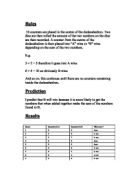

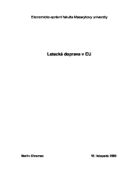
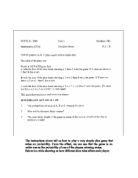
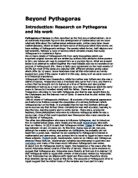
![Pythagoras [Samos, 582 - 500 BC].](https://mbt-essays-prod-public.s3.eu-west-1.amazonaws.com/60910/listing/60910_1.jpg)



